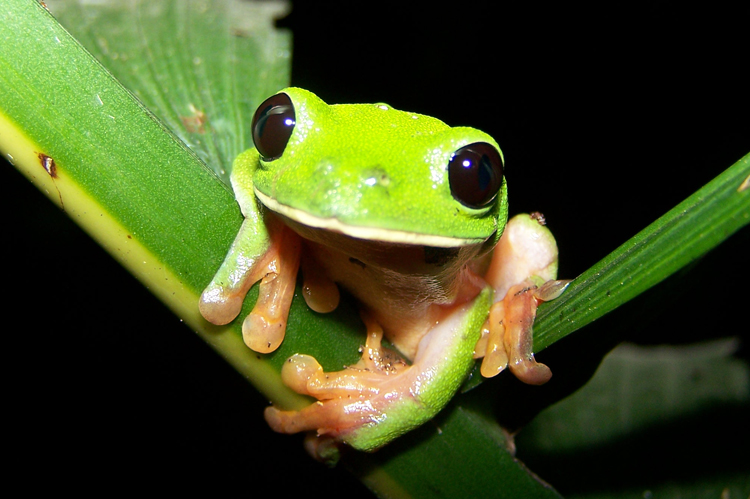Superregnum: Eukaryota
Regnum: Animalia
Subregnum: Eumetazoa
Cladus: Bilateria
Cladus: Nephrozoa
Superphylum: Deuterostomia
Phylum: Chordata
Cladus: Craniata
Subphylum: Vertebrata
Infraphylum: Gnathostomata
Superclassis: Tetrapoda
Classis: Amphibia
Subclassis: Lissamphibia
Ordo: Anura
Familia: Phyllomedusidae
Genus: Agalychnis
Species Agalychnis moreletii
Name
Agalychnis moreletii (Duméril, 1853)
Type locality: "Vera-Paz", Guatemala.
Syntypes: MNHNP 428 (parchment labeled 767) (2 specimens).
Synonyms
Hyla moreletii Duméril, 1853
Hyla holochlora Salvin, 1860
Agalychnis holochlora — Cope, 1865
Agalychnis moreletii — Cope, 1865
Hyla Morelettii — Keferstein, 1868
Phyllomedusa moreletii — Kellogg, 1932
Phyllomedusa (Agalychnis) moreletii — Lutz, 1950
References
Duméril, 1853, Ann. Sci. Nat., Paris, Ser, 3, 19: 169.
Cope, 1865, Nat. Hist. Rev., N.S., 5: 110.
Frost, D.R. 2021. Amphibian Species of the World: an Online Reference. Version 6.1. Electronic Database accessible at https://amphibiansoftheworld.amnh.org/index.php. American Museum of Natural History, New York, USA. DOI: 10.5531/db.vz.0001 Agalychnis moreletii . Accessed on 30 Apr 2008.
2007 IUCN Red List of Threatened Species IUCN: Agalychnis moreletii (Critically Endangered) Downloaded on 30 April 2008.
Vernacular names
English: Morelet's Leaf Frog
Morelet's tree frog (Agalychnis moreletii) is a species of leaf frog in the family Phyllomedusidae. It is found in Belize, El Salvador, Guatemala, Honduras, and Mexico. They have also been called black-eyed leaf frog and popeye hyla.
Its natural habitats are subtropical or tropical moist lowland forest, subtropical or tropical moist montane forest, freshwater marshes, and intermittent freshwater marshes.
Description
This is a frog that has a green body, black eyes, and a red or pink underbelly. They are found in moist subtropical lowland mountainous forests and wetland habitats of Belize, El Salvador, Guatemala, Honduras, and Mexico. They have been collected on the Atlantic and Pacific slopes of Veracruz, Chiapas, the Maya mountains of Belize, northwestern Honduras, and El Salvador. They can live in pristine or disturbed habitats and will breed in temporary or permanent bodies of water. They have an extended breeding season during the summer months. They deposit clutches of 50 to 75 eggs on vegetation or rocks over water. The eggs of the Morelet's tree frog have a green pigment and when they hatch, the larvae fall into the water to complete their development into frogs.
Conservation
Morelet's tree frog are abundant within its range and are kept as pets internationally. Industry and agriculture are thought to be the main causes of lowland montane forest destruction. The population of Morelet's tree frogs are also being affected due to a disease called Chytridiomycosis, which is an infectious disease that kills amphibians. Chytridiomycosis and habitat destruction are projected to cause the population to decline over 80% in the next 10 years. In some regions, the frogs have gone extinct completely. For example, a study done in 2004, has claimed that Morelet's tree frog may be extirpated from the region of Southern Mexico.[2]
Their survival is dependent upon several factors due to their human and disease-caused population decline. Some conservation measures are in place, while others are still in need of implementation or research. Several protected parks have been created to curb habitat destruction in areas of Central America and Mexico. Taxonomic research is currently in place to further understand the population's status. More data are needed, however, on a temporal and spatial scale to determine trends in the population of Morelet's tree frogs.
References
IUCN SSC Amphibian Specialist Group (2017). "Agalychnis moreletii". IUCN Red List of Threatened Species. 2017: e.T55293A53951672. doi:10.2305/IUCN.UK.2017-3.RLTS.T55293A53951672.en. Retrieved 18 November 2021.
Lips, K. R.; J. R. Mendelson 3rd; A. Muñoz-Alonso; L. Canseco-Márquez & D. G. Mulcahy (2004). "Amphibian population declines in montane southern Mexico: Resurveys of historical localities" (PDF). Biological Conservation. 119 (4): 555–564. doi:10.1016/j.biocon.2004.01.017.[permanent dead link]
Further reading
Lee, J.C. 1996. The Amphibians and Reptiles of the Yucatán Peninsula. Cornell University Press. Ithaca, New York, USA.
Duellman, W.E. 2001. The Hylid Frogs of Middle America. Society for the Study of Amphibians and Reptiles. Ithaca, New York, USA.
Retrieved from "http://en.wikipedia.org/"
All text is available under the terms of the GNU Free Documentation License


